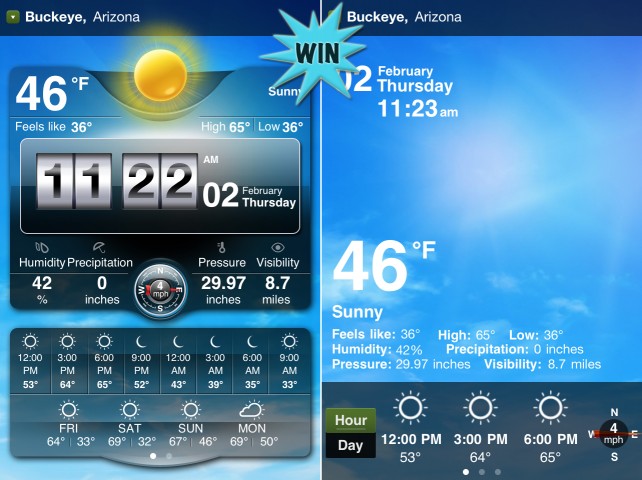
For the past couple of months, I've been walking around with both an
iPhone 4S and a
Samsung Galaxy Nexus, with the former running iOS 5 and the latter running Google's Android 4.0, known as
Ice Cream Sandwich. I posted my initial impressions a while back, after having used both devices for a week or two, but now that I've gotten used to both, I thought I'd reevaluate how they compare in several categories.
 Size
Size: Of course, the Galaxy Nexus, with its 4.65-inch display, is a lot larger than the iPhone 4S, which has a 3.5-inch display. The Nexus measures 5.3-by-2.7-by-0.4 inches, while the iPhone measures 4.5-by-2.31-by-.37 inches. Initially, I thought the size would make carrying the Nexus more difficult, but both fit into my pocket. The Nexus's size makes it better for reading lots of text on a page and for viewing videos, but the iPhone's smaller size means it's easier to carry and to use single-handedly because you can reach all the controls.
Let's call it a wash.
Display: The Nexus display is not only physically bigger, but it also offers higher 1280-by-720-pixel resolution, compared with the iPhone's 960-by-480. That means you can see more on a webpage, for instance. The Nexus display uses Samsung's "Super AMOLED" organic LED display, but uses Samsung's PenTile technology (which has two subpixels per dot, not three); the iPhone uses an IPS LCD display. The basic technology—OLED versus LCD—means that the Nexus has really dark blacks (since it doesn't use backlighting), and thus better contrast. In practice, though, the iPhone looks quite good and is typically brighter. There are pros and cons, but overall I'd give the advantage to the Nexus, mostly because I do a fair amount of browsing and email, and the larger, higher-resolution screen matters.
Advantage: Galaxy Nexus
Camera: The iPhone 4S has an 8-megapixel rear-facing camera; the Nexus has a 5-megapixel one. The iPhone has a VGA resolution front-facing camera; the Nexus has a 1.3MP one. Ice Cream Sandwich gives you a lot more control over the camera settings, with more screen modes and more control over exposure and white balance. But forget the specs; I've now used both, in a variety of situations, and the iPhone 4S simply takes better pictures.
Advantage: iPhone
Network: This is going to vary a lot depending on which carrier you choose, and where you live and travel. The Galaxy Nexus is currently only available in the U.S. as a Verizon LTE phone, whereas iPhones are available on multiple networks. Mine uses AT&T's HSPA+ network. As someone who works in New York but travels to the West Coast pretty often, there's just no question: Verizon's LTE network is faster. I've been particularly happy using it with a hotspot feature (and have stopped using a separate mobile hotspot as a result). For voice calls, Verizon seems to be a bit more reliable than AT&T, but I find that varies a lot by location. I still get no service from Verizon when I'm on the train tracks at Grand Central Terminal, for instance, but AT&T works fine there. At my home, both are fine; at my office, both are horrible. (I thought midtown Manhattan was getting better for a while, but it's gotten worse again.) Traveling, I've seen lots of variability. On balance, I'll give this to LTE.
Advantage: Galaxy Nexus
Battery Life: In part, it may be the LTE support, but this really isn't a competition. I almost always can get through a day with the iPhone 4S without concern but I'm always worried about battery life with the Nexus, and often drain it. Third-party apps to better manage the battery have helped, as has an extended life battery, but it's just not as good.
Advantage: iPhone
Browser: I like the iPhone browser, which is quite fast, but the Nexus's has more features. Sure, everyone talks about the ability to run Flash on Android, but actually, the feature I found most useful was the ability to request the desktop site instead of the mobile one.
Advantage: Galaxy Nexus
Apps: There are plenty of great Android applications, and you will probably be very happy with the selection on either platform. There are a few more
iPhone apps, and in some cases, they are a bit more polished, but Android is catching up.
Voice recognition: Apple has given Siri a lot of attention. There's no question that its ability to query multiple databases simultaneously and generate an answer is more advanced than the relatively straightforward Google Voice Search on Android. Still, other than as I demo, I don't find myself using voice very much; most of the time, I can get what I want a lot faster through a browser. Apple has a noticeable lead here, though I really can't say it matters much to me yet.
Operating System/Stability: Overall, I've found many reasons to applaud the Ice Cream Sandwich version of Android. I really like the way it handles multitasking; a single button that shows you thumbnails of all your loaded applications, making the switch among applications faster and easier. I've seen crashes on both systems (not to mention on Windows and Mac OS X), but in general, the iPhone has been more reliable. As a result, I'm giving Apple the point here, but minor tweaks to Android could change things.
Advantage:
iPhone
Reviewing this list, the iPhone wins in more categories. For the most part, that comes down to software; Apple's iOS 5 is just a bit more refined, and a bit easier to use. Make no mistake, though, Android 4.0 is narrowing the gap quickly. From a hardware perspective, the Android ecosystem just gives you more choices. Users can get a larger display on the Galaxy Nexus, a keyboard on the Droid 4, or a much less expensive Android model. That diversity is a major strength of the Android platform, and Apple can't really compete with that. If I had to pick just one, though, I'd still choose the iPhone 4S today.
By the way, in addition to the iPhone 4S and the Galaxy Nexus, I always have my
BlackBerry Bold 9810, which still has the best corporate mail solution, even if it lacks the application array of the other two. Carrying three phones all the time probably makes me look like a nerd, but that's not really new news.
Original Source


















 If you have an iPhone, chances are you use it daily to find the places you need to go, including health care providers However, although most hospitals are equipped for general medical emergencies, certain hospitals have specialists for specific conditions immediately available. For example, there are hospitals that have designations as “stroke centers” that can rapidly mobilize the necessary equipment and personnel for acute stroke treatment, and the same goes for eye emergencies and pediatric trauma. Now there’s an app that finds the specialized center closest to you based on the type of emergency you’re facing.
If you have an iPhone, chances are you use it daily to find the places you need to go, including health care providers However, although most hospitals are equipped for general medical emergencies, certain hospitals have specialists for specific conditions immediately available. For example, there are hospitals that have designations as “stroke centers” that can rapidly mobilize the necessary equipment and personnel for acute stroke treatment, and the same goes for eye emergencies and pediatric trauma. Now there’s an app that finds the specialized center closest to you based on the type of emergency you’re facing.
















